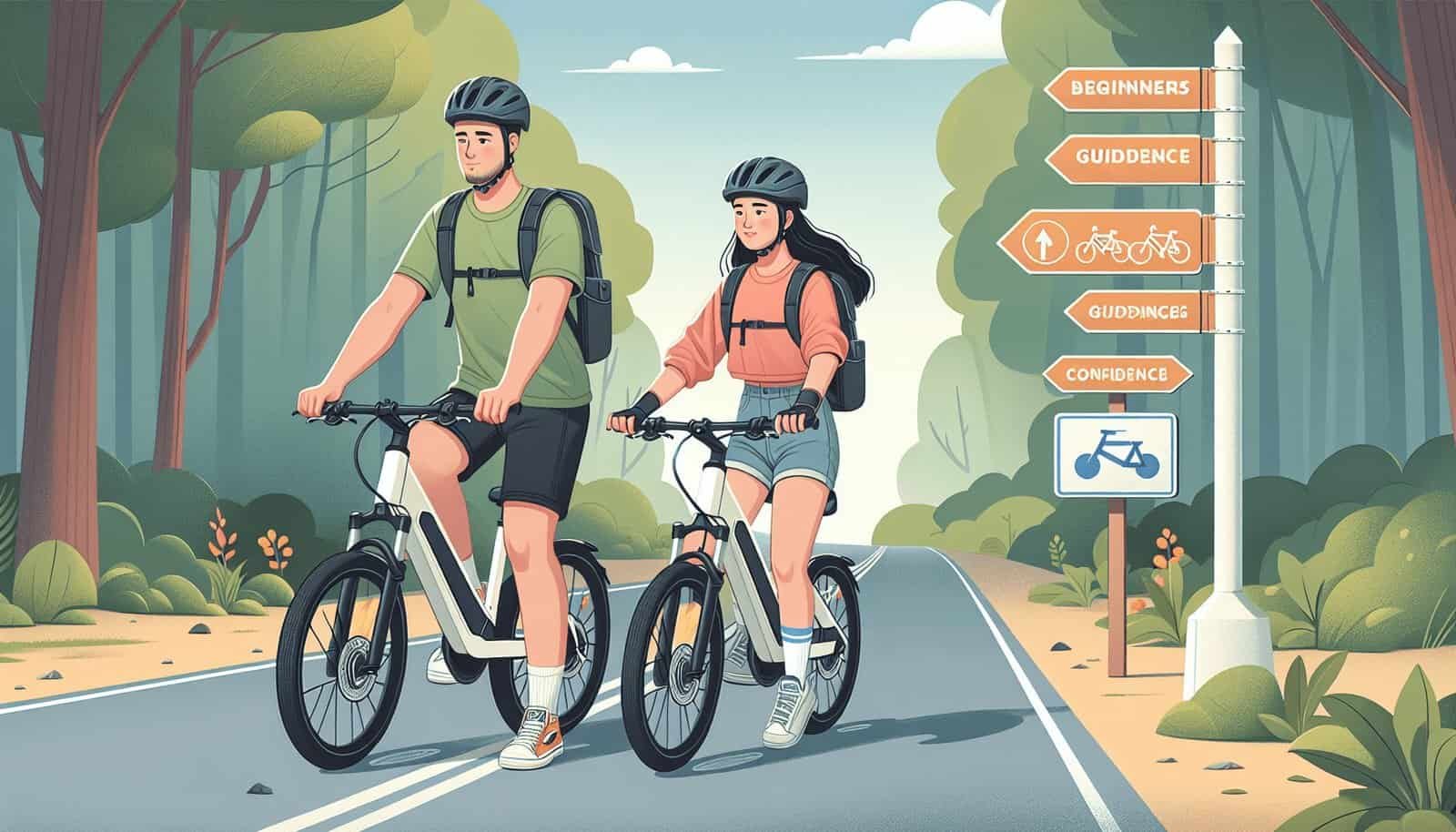If you’ve been wondering whether you can hop on an electric bike with limited cycling experience, the answer is a resounding yes! Whether you’re a beginner or haven’t ridden a bicycle in ages, electric bikes are designed to be user-friendly, making them accessible to riders of all skill levels. With their pedal-assist technology and adjustable settings, electric bikes provide a smooth and comfortable ride, giving you the confidence and support you need to hit the road and enjoy the freedom of cycling, regardless of your experience level. So, rest assured, it’s time to saddle up and embark on your electric biking adventure!

Understanding Electric Bikes
What is an electric bike?
An electric bike, also known as an e-bike, is a type of bicycle that is equipped with an electric motor and a rechargeable battery. This motor provides additional power when the rider pedals, amplifying their effort and making cycling easier and more enjoyable. Electric bikes come in various styles and designs, ranging from traditional-looking bicycles to more specialized models for different purposes.
How does an electric bike work?
Electric bikes work by combining human power with electric assistance. When you pedal an electric bike, the motor detects your pedaling motion and provides an additional boost of power to enhance your riding experience. The power assistance can be regulated through different levels, allowing you to choose the amount of electric assistance you prefer. The energy for the motor is supplied by a rechargeable battery, which can be charged using a conventional power outlet.
Why choose an electric bike?
There are several reasons why you might choose an electric bike over a traditional bicycle. One of the main advantages of e-bikes is that they make cycling more accessible to a wider range of people, including those with limited cycling experience. Electric bikes provide support and assistance, allowing beginners to build confidence and enjoy cycling without feeling overwhelmed by physical exertion. Additionally, electric bikes can be a practical transportation option, especially for commuting or running errands, as they offer a faster and less strenuous alternative to traditional bikes.
Benefits of Electric Bikes for Beginners
Boosted confidence and reduced effort
One of the key benefits of electric bikes for beginners is the boost in confidence they provide. The electric assistance allows riders to maintain a steady and comfortable pace, making it easier to navigate through traffic, climb hills, and keep up with more experienced cyclists. With the added power, beginners can focus on improving their cycling skills and enjoying the ride without being overly concerned about physical exertion.
Assistance in uphill climbs
Uphill climbs can be particularly challenging for beginners, as they require extra effort and stamina. Electric bikes, however, make uphill climbs much more manageable. The motor provides a significant boost in power, allowing riders to conquer steep inclines with less effort. This assistance helps beginners build their strength and endurance gradually, as they become more comfortable tackling more challenging terrains.
Extended range and reduced fatigue
Another advantage of electric bikes for beginners is the extended range they offer. The electric assistance allows riders to travel longer distances without becoming excessively fatigued. This is especially beneficial for those who want to explore new routes, venture into unfamiliar areas, or simply enjoy longer rides without worrying about running out of energy. The reduced physical exertion also means you can cycle for longer periods of time, making biking a more accessible and enjoyable activity.
Factors to Consider
Assessing your physical fitness
Before choosing an electric bike, it’s important to assess your own physical fitness and consider how much assistance you might need. While electric bikes provide support, they still require the rider to pedal in order to activate the motor. If you have limited cycling experience or are not in the best physical condition, it may be wise to opt for a model with a higher level of electric assistance. This will ensure that you can comfortably handle the bike and enjoy your rides without feeling overwhelmed.
Understanding local laws and regulations
It’s crucial to familiarize yourself with the local laws and regulations regarding electric bikes in your area. Different regions may have specific rules regarding speed limits, age restrictions, helmet requirements, and where electric bikes are allowed to be ridden. Understanding these regulations will help ensure your safety and compliance with the law while riding your electric bike.
Choosing the right electric bike model
Choosing the right electric bike model is essential for beginners. Consider factors such as the type of terrain you’ll be riding on, your intended use of the bike (commuting, leisure, off-road, etc.), and your budget. Different electric bikes are designed for different purposes, so selecting a suitable model will enhance your overall riding experience. It’s also important to test-ride various models to ensure the bike’s comfort and fit before making a purchase.
Getting Started with Electric Bikes
Electric bike safety tips
When getting started with electric bikes, it’s important to prioritize safety. Observe basic safety precautions such as wearing a properly-fitted helmet, using appropriate lighting and reflectors, and following traffic rules. Familiarize yourself with the bike’s controls, including the brakes, throttle, and power settings. Take the time to learn how to turn the electric assistance on and off, as well as how to adjust the bike’s settings to suit your needs.
Learning basic cycling techniques
Even if you have limited cycling experience, learning basic cycling techniques is fundamental. Practice maintaining balance, starting and stopping smoothly, and executing turns. Familiarize yourself with the bike’s gears and learn how to shift efficiently for different terrains. Taking the time to develop these foundational skills will improve your overall riding experience and help you feel more confident on an electric bike.
Gradually building confidence and skills
Starting slowly and gradually building confidence and skills is key when getting started with electric bikes. Begin by riding in low-traffic areas, such as bike paths or quiet residential streets, before venturing into busier roads. Take short rides at first and gradually increase the distance and difficulty of your routes as your skills and comfort level improve. This progressive approach will allow you to adapt to the electric bike’s features and gain confidence in your riding abilities.

Selecting the Right Electric Bike
Different types of electric bikes
There are various types of electric bikes available, each designed for different purposes. Some common types include commuter electric bikes, mountain electric bikes, and folding electric bikes. Commuter electric bikes are ideal for urban environments and daily transportation, while mountain electric bikes are built to handle rough off-road terrains. Folding electric bikes are compact and convenient for storage and transportation. Consider your intended use of the bike and choose a type that suits your needs and preferences.
Choosing the appropriate frame size
Choosing the appropriate frame size is essential for both comfort and safety. An electric bike with the correct frame size will provide a comfortable riding position and optimal control. The frame size should be suitable for your height and leg length. It’s recommended to visit a local bike shop or consult a professional to ensure that the electric bike you choose is the right fit for your body proportions.
Considering battery range and power
Battery range and power are important factors to consider when selecting an electric bike. The battery range refers to the distance the bike can travel on a full charge, while power determines how quickly the bike accelerates and climbs hills. Assess your intended usage and determine the minimum battery range and power requirements that will suit your needs. Keep in mind that higher power and longer range may come with an increased price and possibly added weight.
Learning and Improving Cycling Skills
Practicing balance and control
Balance and control are fundamental skills for any cyclist, regardless of experience level. Practice balancing on your electric bike, riding in a straight line, and making gradual turns. As you become more confident, try maneuvering through obstacles or practicing slow-speed handling. These exercises will improve your overall stability and control while riding.
Braking techniques
Understanding and mastering braking techniques is crucial for safe riding. Electric bikes are typically equipped with different types of brakes, such as disc brakes or rim brakes. Familiarize yourself with the specific braking system on your bike and practice applying the brakes smoothly and effectively. Learn to modulate the braking force to match various riding conditions and maintain control of the bike at all times.
Navigating turns and obstacles
Navigating turns and obstacles is an essential skill for any cyclist. Practice turning smoothly and confidently, using your body weight and leaning into the turns. Additionally, practice maneuvering around obstacles such as potholes or curbs, ensuring you maintain control and balance while avoiding potential hazards. These skills will help you become a more skilled and confident electric bike rider.

Joining Electric Bike Communities
Finding local groups or clubs
Joining electric bike communities is a great way to connect with other riders and gain insights and knowledge. Look for local electric bike groups or cycling clubs in your area. These communities often organize group rides, social events, and provide a platform for exchanging tips and experiences. Joining a community will introduce you to like-minded individuals who share a passion for electric biking and can offer support and guidance.
Participating in group rides and events
Participating in group rides and events organized by electric bike communities is an excellent opportunity to enhance your riding skills and gain confidence. Group rides provide the chance to ride with more experienced cyclists, observe their techniques, and learn from their experiences. It’s also a fun and social way to explore new routes and enjoy the company of fellow electric bike enthusiasts.
Learning from experienced electric bike riders
Experienced electric bike riders can offer valuable advice and insights that can help you improve your riding skills. Engage in conversations with experienced riders, ask questions, and seek their guidance. They can provide tips on maintenance, handling different terrain, and optimizing your electric bike’s performance. Learning from those who have already gone through the learning process will accelerate your progress and contribute to a more enjoyable riding experience.
Maintenance and Upkeep
Understanding basic maintenance tasks
Proper maintenance is essential to keep your electric bike running smoothly and ensure its longevity. Familiarize yourself with basic maintenance tasks such as cleaning and lubricating the chain, checking tire pressure, and inspecting the brakes. Regularly perform these tasks and address any issues promptly to prevent more significant problems from developing. If you’re unsure about any maintenance tasks, consult the bike’s user manual or visit a professional bike shop for assistance.
Keeping the battery in good condition
The battery is a crucial component of an electric bike, and taking care of it is essential. Follow the manufacturer’s guidelines for charging and storing the battery. Avoid charging the battery to its maximum capacity unless necessary and avoid extreme temperatures, as they can affect battery performance. Regularly check the battery’s connections and ensure they are clean and secure. By properly maintaining the battery, you can optimize its lifespan and performance.
Regularly checking and adjusting bike components
Regularly checking and adjusting various bike components will help maintain optimal performance and safety. Pay attention to the condition of the tires, brakes, gears, and suspension (if applicable). Ensure that they are in good working order and adjust them as needed. Regularly inspect the frame and handlebars for any signs of damage or wear. If you notice any issues or abnormalities, address them promptly to prevent further damage or potential accidents.

Improving Confidence and Experience
Setting achievable goals
Setting achievable goals is a great way to improve your confidence and expand your electric biking experience. Start by setting small, realistic goals, such as completing a certain distance or conquering a specific hill. As you meet these goals, gradually increase the level of difficulty or distance. Celebrate your achievements along the way, and remember that every milestone reached is an opportunity to grow and build upon your skills as a cyclist.
Exploring new routes and terrains
Exploring new routes and terrains is an exciting way to expand your electric bike experience. Venture out of your comfort zone and try riding in different environments, such as urban areas, rural roads, or off-road trails. Discover new scenic routes or places of interest in your area. By exploring new routes and terrains, you’ll not only improve your navigation and adaptability skills, but also gain a deeper appreciation for the versatility and capabilities of your electric bike.
Gradually reducing electric assistance
As you become more comfortable and experienced with your electric bike, gradually reducing the level of electric assistance can be a rewarding challenge. Start by selecting a lower assistance level for certain parts of your ride, such as downhill stretches or flats. Over time, gradually reduce the assistance level for longer durations until you eventually rely more on your own power and less on the electric motor. This progression will help you develop your physical fitness and cycling abilities, ultimately making you a more well-rounded cyclist.
Conclusion
Overcoming limited cycling experience is made possible by the many benefits that electric bikes offer. By providing boosted confidence and reducing effort, electric bikes allow beginners to comfortably navigate through various terrains and adapt to the world of cycling. With assistance in uphill climbs and extended range, electric bikes become both a practical transportation option and a source of enjoyment. By considering factors such as physical fitness, local regulations, and choosing the right model, beginners can select an electric bike that best suits their needs. From there, learning and improving cycling skills, joining electric bike communities, and maintaining the bike will contribute to an enhanced experience. As your confidence and experience grow, setting achievable goals, exploring new routes, and gradually reducing electric assistance will allow you to fully embrace the benefits of electric bikes and continue to evolve as a cyclist.


